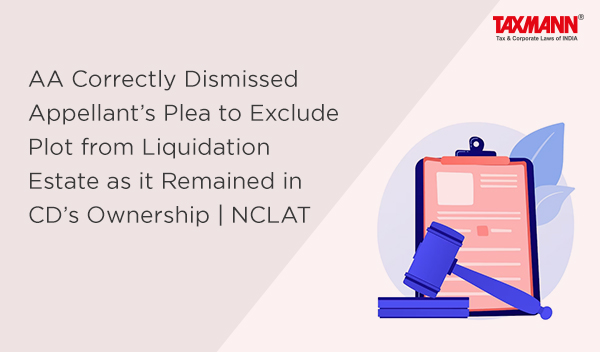AA Correctly Dismissed Appellant’s Plea to Exclude Plot from Liquidation Estate as it Remained in CD’s Ownership | NCLAT
- Blog|News|Insolvency and Bankruptcy Code|
- 2 Min Read
- By Taxmann
- |
- Last Updated on 29 November, 2023

Case Details: K. Jayant Prabhu v. Pankaj Srivastava - [2023] 156 taxmann.com 351 (NCLAT-Chennai)
Judiciary and Counsel Details
-
- M. Venugopal, Judicial Member & Shreesha Merla, Technical Member
- Sriranga Subbanna, Sr. Adv. & Ms Sumana Naganand, Adv. for the Appellant.
- Abhishek Anand & Ms Shriraja S., Advs. for the Respondent.
Facts of the Case
In the instant case, the Appellant/homebuyer entered into a sale agreement with corporate debtor for purchase of a plot in schedule ‘A’ property and booked a villa to be constructed on said plot developed by corporate debtor (referred as schedule B property).
Since corporate debtor was delaying completion of pending work in schedule A property, it permitted appellant to take possession of villa and start interior work. Corporate debtor went under liquidation and a liquidator was appointed.
Subsequently, the Appellant filed its claim requesting liquidator to register schedule B property in favour of appellant and to execute said sale deed. Appellant also filed a claim of an amount which was incurred by appellant on unfinished work of schedule A property.
Further, the Claim of appellant for amount incurred was admitted by liquidator but appellant was directed to handover control and custody of schedule B property to liquidator.
Also, the Appellant filed an application before NCLT praying for direction to liquidator to exclude schedule ‘B’ property from liquidation estate of corporate debtor, however, NCLT dismissed the same vide impugned order.
Further, it was noted that neither security interest was created in favour of appellant nor a registered sale deed was executed between appellant and corporate debtor, and only being in possession of an immovable property would not have conferred any ownership right upon a person.
NCLAT Held
Since in instant case, ownership of said property rested with corporate debtor, the NCLAT held that impugned order was free from legal flaws.
List of Cases Reviewed
-
- K. Jayant Prabhu v. Pankaj Srivastava [2023] 156 taxmann.com 350 (NCLT – Beng.) (para 40) affirmed [See Annex].
List of Cases Referred to
-
- Alok Sharma v. IP Construction (P.) Ltd. [2022] 142 taxmann.com 298 (NCLAT – New Delhi) (para 5)
- Flat Buyer’s Association Winter Hills-77, Gurgaon v. Umang Realtech (P.) Ltd. [2020] 119 taxmann.com 50 (NCLAT) (para 8)
- Narayan Das Khettry v. Jatindra Nath Roy Chowdhury 1927 IA 218 (para 11)
- Dr. K.A. Dhairyawan v. J.R. Thakur AIR 1958 SC 789 (para 12)
- Narandas Karsondas v. S.A. Kamtam [1977] 3 SCC 247 (para 22)
- Suraj Lamp & Industries (P.) Ltd. v. State of Haryana [2011] 14 taxmann.com 103/202 Taxman 607/[2012] 340 ITR 1 (SC) (para 23)
- Jaypee Kensington Boulevard Apartments Welfare Association v. NBCC (India) Ltd. [2021] 125 taxmann.com 360/166 SCL 78 (SC) (para 30).
Disclaimer: The content/information published on the website is only for general information of the user and shall not be construed as legal advice. While the Taxmann has exercised reasonable efforts to ensure the veracity of information/content published, Taxmann shall be under no liability in any manner whatsoever for incorrect information, if any.

Taxmann Publications has a dedicated in-house Research & Editorial Team. This team consists of a team of Chartered Accountants, Company Secretaries, and Lawyers. This team works under the guidance and supervision of editor-in-chief Mr Rakesh Bhargava.
The Research and Editorial Team is responsible for developing reliable and accurate content for the readers. The team follows the six-sigma approach to achieve the benchmark of zero error in its publications and research platforms. The team ensures that the following publication guidelines are thoroughly followed while developing the content:
- The statutory material is obtained only from the authorized and reliable sources
- All the latest developments in the judicial and legislative fields are covered
- Prepare the analytical write-ups on current, controversial, and important issues to help the readers to understand the concept and its implications
- Every content published by Taxmann is complete, accurate and lucid
- All evidence-based statements are supported with proper reference to Section, Circular No., Notification No. or citations
- The golden rules of grammar, style and consistency are thoroughly followed
- Font and size that’s easy to read and remain consistent across all imprint and digital publications are applied





